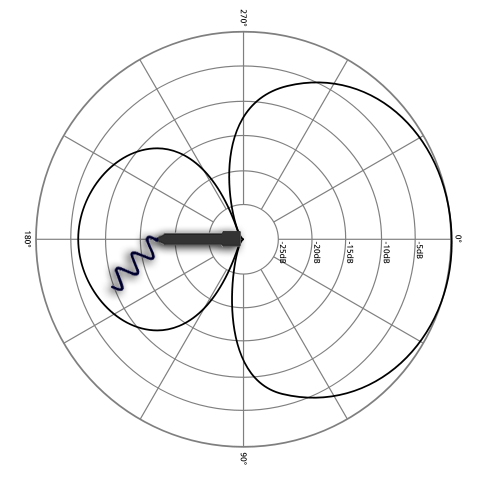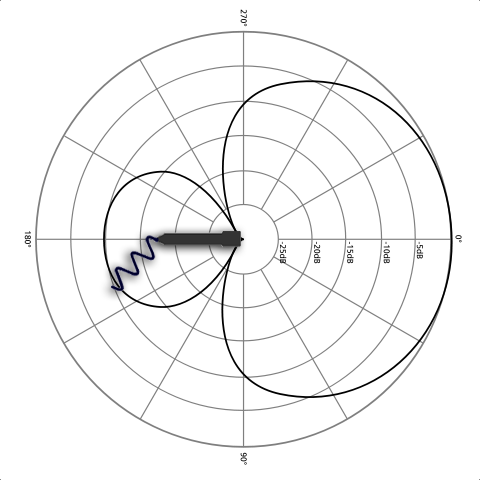Chapter Two: Studio Gear

3. Microphones | Page 4
Microphone Patterns (single microphone)
Depending on their design and construction, microphones respond to sound coming from different directions with varying degrees of sensitivity. A plot or graph of this response is called a polar pattern (sometimes polar response curve). Two-dimensional polar patterns are slices through the central axis of a three-dimensional pickup pattern which you can imagine in 3D by rotating the plot 360° on its x-axis, or viewing this 3D Beyerdynamic plot (it looks more like a futuristic tech graphic from a Spiderman movie).
The most frequently used single microphone patterns are (select to scroll to plot):
Cardioid | Hypercardioid | Supercardioid | Figure-8 | Omnidirectional
One pattern is not 'better' than another—it depends on how you choose to use a particular mic, which sound characteristics you are most after (more or less room ambience, feedback avoidance for live sound, etc.), and what the nature of your sound source is. It is important to note that polar patterns are frequency-dependent. Typically, low frequency response will be almost omnidirectional; the polar pattern, even for omnidirectional mics, will become more directional as frequency rises. For our purposes, a general graph of patterns are used here, but before putting a lot of money down on a good microphone, it may be prudent to view the pattern response for various frequency bands for the mics you are considering and make sure it is best suited for the uses you have in mind. For example, this AKG C414 XLS hypercardioid plot (hover to see, click for full C414 data sheet) indicates a much wider pickup pattern for 2 kHz-8 kHz than for 16 kHz and above. The degree of pattern difference in these frequency bands as sound moves around a mic off the front is called off-axis coloration. Typically, as is the case with this C414 plot, many mics lose their higher frequency sensitivity off-axis compared to their low end.
Polar Pattern Plots: The direction of the arriving sound relative to the axis of the mic called the angle of incidence. Looking at a mic's polar pattern will tell you how directional it is, how well it will reject sound from certain directions, etc. The plots aid in assessing the pattern's acceptance angle which can be defined as the angle before sensitivity drops -3 dB. As you examine the plots below, note for example that the standard cardioid would have a 120° angle of acceptance while the supercardioid would exhibit an angle of acceptance of roughly 100°, indicating the degree of directionality of the mic choice.
Some microphone patterns are bidirectional because they have more than one 'lobe' or area of response bounded by a null or near-null where virtually all sound is rejected. Sound entering these lobes are in usually in reverse phase to their 'on-axis' counterpart.
How to Read: The plots on this page indicate the amount of sensitivity relative to angle of incidence, with 0° being directly on-axis to the front of the mic. The concentric circles show descending sensitivity in -5 dB increments. Looking at the cardioid graph immediately below, it indicates that for sound arriving at 0°, the relative sensitivity is at the maximum, with 0 dB attenuation, but for sound arriving 120° off-axis, the sensitivity drops by approximately 12 dB's, as the plot crosses between the -10 and -15 circles at the 120° mark.

Cardioid mics are characterized by strong sensitivity to audio from the front ('on-axis'), good sensitivity on the sides (at 90 degrees, approx. 6 dB less than the front), and good rejection of sound from the rear. The cardioid pattern can almost be visualized as a heart-shaped pattern (hence its name). The ability to reject sound from the rear makes cardioid patterns very useful in multi-miking situations, and where it is not desirable to capture a large amount of room ambience from behind. Popular in both studio and live use (where rear rejection cuts down on feedback and ambient noise), cardioid mics are used for a very high percentage of microphone applications. Keep in mind that like all non-omnidirectional mics, cardioid mics will exhibit pronounced proximity effect and be more sensitive to sharp transients like vocal plosives.
Cardioid mics work on the pressure-gradient principle, whereby a hollow labyrinth of channels behind the diaphragm, often through side vents, ports or a rear screen, allows time-delayed sound onto the rear of the diaphragm, and in reverse phase to the incident sound at the front of the diaphragm, helping to create the null from behind with phase cancellation.
Cardioid mics are very commonly used in stereo pair mic'ing, such as x-y coincident and ORTF or near-coincident techniques, and usually the front-pointing one of the Mid-Side mics for M-S recording.
There is a variant of the cardioid pattern known as wide cardioid, also sometimes called subcardioid, which acts as a compromise between an omni and a cardioid. It has a very broad front area (hence "wide"), no null points, and picks up sound uniformly, but to a lesser degree, from the rear. The newer AKG C414 models added this pattern.

Hypercardioid patterns are similar to cardioid patterns in that the primary sensitivity is in the front of the microphone. They differ, however, in that the points of least sensitivity (again, called nulls) are at the 100˚and 250˚ positions, as opposed to directly behind the microphone in a cardioid pattern. Hypercardioid microphones are thus considered even more directional than cardioid and supercardioid microphones, with an acceptance angle of only 90˚ for a 3 dB drop compared to the cardioid's 120° angle.
Hypercardioid microphones are frequently used in situations where maximum isolation is desired between off-axis sound sources, including for film work. The rear lobe receives a lesser amount of sound from behind than the front, and it is in inverted phase relative to the front. This pattern is a good choice if you wish to include some room ambience from the back of the hall or other environment. A hypercardioid pattern can be considered as the half-way point between a cardioid and a figure-8 in terms of its bi-directionality. For live sound, it's a good idea not to point the rear lobe directly at something like a stage monitor without feedback control. As with the cardioid, the hypercardioid mic works on the pressure-gradient principle, as well as being sensitive to the proximity effect and sharp transients like plosives.

Supercardioid patterns are very similar to, and often confused with, the hypercardioid pattern. It typically has null points around 127˚ and 233˚. The supercardioid pattern is slightly less directional than the hypercardioid pattern, and the rear lobe of sensitivity is also much smaller than the hypercardioid. The supercardioid also works on the pressure-gradient principle, and is therefore also sensitive to the proximity effect and sharp transients like plosives.
Highly-directional shotgun mics usually have a hyper- or supercardioid capsule placed deep inside a long tube (called an interference tube) that physically rejects most sound not directly on-axis, with a small amount allowed in from the rear. These are very popular for video applications, mounted on the camera, since they acquire sound primarily in the direction the camera is pointed. Some lobar shotguns may have small lobes on the side as well from vents in the tube.

In the figure-8 or bi-directional microphone polar pattern, the mic is (nearly) equally sensitive to sounds picked up from front and back, but not sensitive to sounds on the sides, particularly at the 90° and 270° nulls. This produces a pattern that looks like a figure-8 on paper, where the microphone is at the point of crossover on the '8.' Many of these microphones form the pattern with a second cardioid capsule and diaphragm attached the rear of the backplate. They work on the pressure-gradient principle mentioned above. A Blumlein pair, shown on the next page, uses a pair of figure-8 microphones at right angles to each other.
Because they are pressure-gradient mics with no rear attenuation, figure-8 microphones are the most susceptible to overloading with sharp transients like plosives and also demonstrate the most proximity effect. Figure-8 mics are almost always side-address mics, like the AKG C414 mentioned above. Most ribbon mics, in that the ribbon is almost always exposed equally to the front and back of the mic, will have a figure-8 option.

An omnidirectional mic (often called an omni) has a theoretically identical sensitivity in all directions, though often physical structures on the mic prevent a perfect circle of response. In addition, as mentioned earlier, omnis may become more directional at higher frequencies. An omnidirectional microphone will not exhibit a pronounced proximity effect. Omni pairs have been used to create special spacial effects in concert halls by hanging one a significant distance behind the other, resulting in intentional phase differences controllable by the mix at the board. This arrangement allows engineers to control the amount of drier direct signal vs. ambient reverberant signal.
The British recording company Decca found a pleasing pattern to record orchestral music using two spaced omni's, with the center being bolstered by an additional single cardioid or omni. This pattern, with many variations, is known as a Decca tree, and variations would include hanging a second pair of "outrigger" omnis even wider near the outer edges of the ensemble, for example.
Unlike the other patterns listed above, a true omni mic works on the pressure, not pressure-gradient, principle in that only the front of the diaphragm is exposed to the sound. Some mics, like the AKG C414 that have back-to-back capsules, will somewhat less successfully execute an omni option without partial nulls at the sides by mixing the rear capsule in phase with the front capsule.